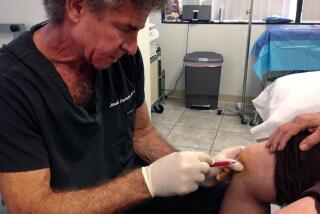U.S. to Fund Controversial Stem Cell Research
WASHINGTON — The federal government announced Wednesday that for the first time it will fund medical research using human embryo cells, touching off a bitter debate between anti-abortion groups and patients with diabetes, heart disease and other ailments. President Clinton said the research had “breathtaking” promise and added: “I think we cannot walk away from the potential to save lives and improve lives.”
Research opponents, who believe it is immoral to use embryos as laboratory materials, vowed to block the administration in Congress or the courts.
But even if opponents succeed, more ethical battles are on the horizon, people on both sides of the debate say. Advances in genetics and embryology are raising thorny questions as never before about the proper treatment of early human life.
Already, one company has aimed to cure disease by merging human cells with cow cells, creating a hybrid that some people find repugnant.
And soon, parents will be able to screen embryos for a wide variety of traits--not only disease, but hair color and height--bringing them new options to choose their own children.
“You don’t need a crystal ball to see the questions that are going to come up in the next five years,” said Glenn McGee, assistant professor of bioethics at the University of Pennsylvania. “Even our notion of what an embryo is is in flux. We are literally making up the rules for what it means for life to begin.”
In a long-awaited move, the National Institutes of Health on Wednesday invited scientists to apply for the first-ever federal grants for research using embryo stem cells. These cells, which develop when the embryo is only a few days old, have the power to grow into almost any tissue or cell in the body. Scientists hope to grow them into new brain cells for Alzheimer’s patients, new pancreas cells for diabetics, nerve cells for spinal cord injury victims and the like.
Embryo stem cells were first isolated just two years ago, and some scientists in the private sector already have been working with them. Now, the field could get a major boost as more scientists apply for funding from the NIH, the largest supporter of U.S. medical research. They would have to follow a set of ethics guidelines that the agency released Wednesday after more than a year of internal review.
However, advances in research are likely to raise new challenges to the NIH rules--and to other current restrictions on embryo research. For example, the NIH said it will only fund work using embryos created but not used by couples during the course of fertility treatments.
But eventually, scientists will want to work with embryos they create in their own labs using genetic material from their patients, something now barred even by the new NIH rules. The stem cells from those embryos could be transplanted back into a patient’s body with a lowered risk of rejection, said Dr. Paul Berg, a Nobel laureate from Stanford University.
While producing these embryos might help patients, it raises alarm bells even beyond the anti-abortion community. “If we deliberately produce embryos for utilitarian purposes, then there’s really almost no boundary beyond that,” said Stuart Newman, a developmental biologist at New York Medical College in Valhalla, N.Y. Newman supports abortion rights, but worries that producing embryos for medical treatments might lead to the commercialization of human life.
One company, Advanced Cell Technology Inc. of Worcester, Mass., created a stir two years ago by announcing that it had merged DNA from one of its own researchers with the egg cell from a cow. The resulting human-cow hybrid was not allowed to grow for more than a few days, but it suggested that the technology might have some advantages. Cow eggs are less costly and easier to obtain than human egg cells, and the embryos they produce may well contain stem cells that could be transplanted in patients.
In its new rules, the NIH says it will not fund work that merges human and animal cells, a restriction that might change over time, McGee said. Opposition to the research may disappear “when people understand that a human-animal hybrid means not wasting a human egg on research, not putting a woman at risk to donate an egg and not destroying an embryo that could ever grow into a human,” he said.
Also on the horizon are new techniques that will allow prospective parents to learn more about their unborn children than ever before. Many parents already test their prospective children for Down’s syndrome and other diseases, and may choose abortion when the tests are positive. But the new tests are likely to raise ethical dilemmas by testing for genes that indicate a child has a chance to develop a disease that may or may not come to pass.
“It is not unlikely that within the next few years, some couples who have the money will begin to request tests for non-disease purposes, to look at things like height or skin or hair color,” said Ronald Green, a Dartmouth College bioethics professor who formerly worked with the government’s Human Genome Project.
It is unclear, however, whether people who now see these tests as unethical will become comfortable with them over time. Critics of stem cell research say it may desensitize people to the ethical considerations that now bar scientists and parents from doing things with embryos that should never be done.
“Once the NIH has crossed the line and decided to treat living embryos as something less than human beings, then anything goes,” said Douglas Johnson, legislative director of the National Right to Life Committee, who added that the agency’s stem cell plan “proposes for the federal government to arrange for killing members of the human family.”
Ultimately, said Newman, using embryos to treat illness might lead the public to accept one of the touchiest proposals: allowing people to have children through cloning. “Once people get used to the idea of making embryos for therapeutic purposes, why not let them grow into people?” he asked.
But Alexander Capron, a professor of law and medicine at USC, disputed the idea that embryo science was on a slippery slope that would necessarily lead to reproductive clones. In fact, he said, scientists may eventually be able to produce stem cells without creating embryos at all.
Under the NIH plan released Wednesday, researchers would have to submit their stem cell proposals to a new review committee, whose members have not been named and who will not meet until December. The first dollars would not reach researchers until next year.
That gives opponents time to try to stop the agency, said Rep. Jay Dickey (R-Ark.), a leading critic of the NIH plan. He said opponents might sue the agency on grounds that its plan violates a law prohibiting federal funding for research in which embryos are destroyed. The NIH says its plan is legal because researchers will not be able to spend federal money to dissect embryos and harvest stem cells, but only to work with cells already created at private facilities.
Opponents also could appeal to the next president, who will have the power to stop the NIH plan with an executive order. Vice President Al Gore, the Democratic nominee, supports stem cell research, while Texas Gov. George W. Bush, the Republican nominee, has said through surrogates that he opposes it.






